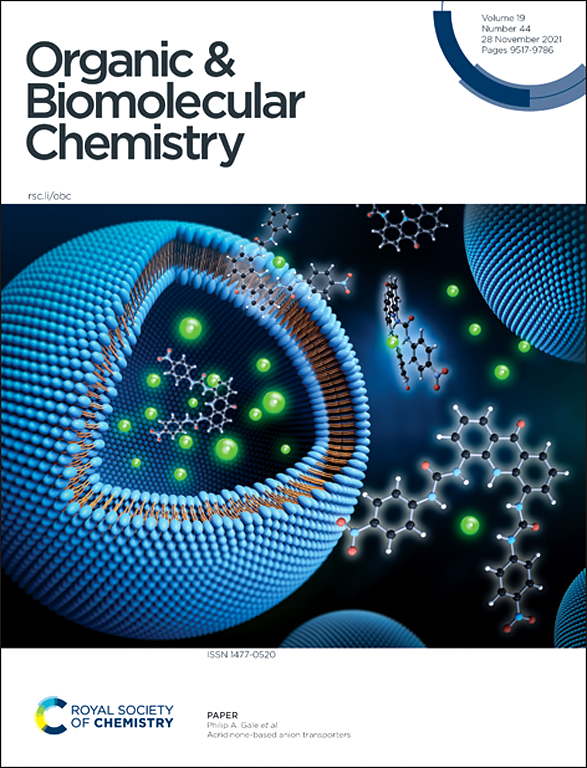An albumin unfolding and refolding cycle induced by a time-controlled pH jump†
IF 2.7
3区 化学
Q1 CHEMISTRY, ORGANIC
引用次数: 0
Abstract
Given the intimate connection between the structure and function of biological macromolecules, the ability to temporally control their unfolding–refolding process enables temporal regulation over specific functionalities, potentially applicable in innovative domains, including the construction of protein-based actuators or programmable catalysis and drug release in complex biotechnological processes. We show here how a temporally controlled protein unfolding–refolding cycle can be coupled in time with programmed pH sequences achieved through the spontaneous decomposition of an activated carboxylic acid. Specifically, we illustrate this process at the molecular level using albumin, the most prevalent protein found in plasma, for which a temporary shift from native to unfolded forms is promoted using nitroacetic acid, able to undergo base-catalysed decarboxylation when solubilized in water solution. As detected by small angle X-ray scattering and intrinsic tryptophan fluorescence, starting from the protein in its native form, the acid addition triggers unfolding to a partially denatured state and a subsequent time-tunable pH rise with gradual refolding that recapitulates the intermediate steps detected at the same pH values by static acidification, fitting within a framework of full reversibility of the structural changes as a function of the protein protonation state. At the end of the pH jump, the native structure is fully recovered, making this method a chemical tool to achieve a complete protein conformational sequence programmed in the timeframe of minutes without further intervention.

由时间控制的 pH 值跃迁诱导的白蛋白展开和再折叠循环。
鉴于生物大分子的结构与功能之间的密切联系,在时间上控制其展开-重折叠过程的能力可实现对特定功能的时间调控,这可能适用于创新领域,包括构建基于蛋白质的致动器或复杂生物技术过程中的可编程催化和药物释放。我们在此展示了如何通过活化羧酸的自发分解,将时间控制的蛋白质展开-重折叠循环与程序化 pH 序列及时结合起来。具体来说,我们使用血浆中最常见的蛋白质白蛋白在分子水平上说明了这一过程,使用硝基乙酸促进了白蛋白从原生形态到展开形态的暂时转变,当白蛋白溶解在水溶液中时,能够发生碱催化的脱羧反应。通过小角 X 射线散射和内在色氨酸荧光的检测,从蛋白质的原生形态开始,加酸会引发蛋白质展开到部分变性状态,随后 pH 值会随着时间的推移逐渐升高并逐渐重新折叠,这再现了静态酸化在相同 pH 值下检测到的中间步骤,符合结构变化作为蛋白质质子化状态函数的完全可逆性框架。在 pH 值跃迁结束时,原生结构会完全恢复,从而使这种方法成为一种化学工具,可在数分钟内实现完整的蛋白质构象序列编程,而无需进一步干预。
本文章由计算机程序翻译,如有差异,请以英文原文为准。
求助全文
约1分钟内获得全文
求助全文
来源期刊

Organic & Biomolecular Chemistry
化学-有机化学
CiteScore
5.50
自引率
9.40%
发文量
1056
审稿时长
1.3 months
期刊介绍:
Organic & Biomolecular Chemistry is an international journal using integrated research in chemistry-organic chemistry. Founded in 2003 by the Royal Society of Chemistry, the journal is published in Semimonthly issues and has been indexed by SCIE, a leading international database. The journal focuses on the key research and cutting-edge progress in the field of chemistry-organic chemistry, publishes and reports the research results in this field in a timely manner, and is committed to becoming a window and platform for rapid academic exchanges among peers in this field. The journal's impact factor in 2023 is 2.9, and its CiteScore is 5.5.
 求助内容:
求助内容: 应助结果提醒方式:
应助结果提醒方式:


